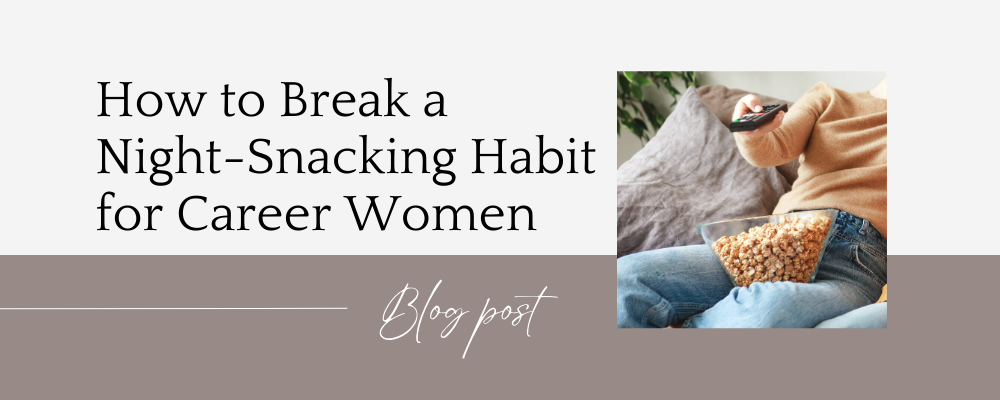How to Break a Night-Snacking Habit for Career Women

How to Break a Night-Snacking Habit for Career Women
You come home from work. It’s either been a stressful day or a non-stressful day.
You do your normal tasks, finally get a break to sit down to relax, and then the snacks start whispering your name from the pantry.
You just had dinner not long before, so why are snacks on your mind?
There are various reasons, but the most common one is that it is a habit that has already been formed.
So your brain gets its cue from you sitting down in the evening to relax. That triggers it to think about the snacks.
But where did that habit begin? Most likely the snack helped provide some pleasure at the end of the work day. Like a reward.
Or, it helped (sort of artificially) decrease discomfort from a negative emotion, such as stress or worry.
Your brain linked all that together and you’re now stuck in that habit cycle. Don’t worry though, because here is how to break a night-snacking habit for career women.
- LISTEN OR READ: Are You Using Food as an Escape? (Podcast Episode)
- LISTEN OR READ: Stress and Eating Habits (Podcast Episode)
Step 1 – Decrease the Snacking Trigger
If you have a night-time snacking habit, then you need to start breaking this habit cycle by decreasing the trigger.
As I mentioned earlier, this can be a negative emotion such as stress, worry or tension. The snack is then seen as something that decreases the discomfort of that.
The trigger can also be just be you sitting on the couch (or a chair) at a certain time. (It can also be both.)
If you suspect that the trigger is from tension for example, then of course decreasing that tension in another way besides with food will be incredibly helpful.
Something like a quick shoulder self-massage can help increase relaxation. A few slow, deep breaths maybe.
Also, you can do something called processing the emotion. This is when you identify the emotion and then describe to yourself how exactly it feels in your body.
Doing this helps your brain understand that the emotion isn’t a terrible thing that needs to go away quickly (with food). This practice is key for any type of emotional eating.
- LISTEN OR READ: Part 1: Eating Behavior Triggers (Podcast Episode)
- LISTEN OR READ: Stress Eating (Podcast Episode)
If you’re unsure of what exactly is triggering you, then at the very least, you know sitting in the same place at roughly the same time is one trigger.
You can try changing up where you sit. You can try doing your after-work or nightly tasks in a different order.
Many of my clients find that keeping their hands busy with a hobby can help. I personally find that immersing myself in a book or conversation with my husband helps.
Just try changing it up and see what might work well for you (and follow the next steps).
Step 2 – Make the Snacking More Difficult to do
If something is easy to do, guess what will happen? You’ll be more likely to do it of course.
The opposite is true too. If something is more difficult to do, your brain will be a little less inclined to do it.
So, if you have snacks in the house, put them in a place that isn’t as easy to get to. You could go as far as putting them in the attic or basement if want.
Or, you can put them in the back of the pantry or snack cabinet and wrap them in plastic wrap or aluminum foil (foil is recyclable) to make it more difficult to get into them.
Now of course, you’re still physically able to still get to the snacks and eat them, but adding a little bit of difficult to it, just creates a little more friction.
It allows for you to think about what you’re doing and make a more deliberate decision. Rather than letting that more automatic part of the brain kick in.
- LISTEN OR READ: Part 2: Making it More Difficult (Podcast Episode)
- LISTEN OR READ: Mindless Snacking & How to Stop (Podcast Episode)
- GET WEEKLY TIPS: Eating Habit and Weight Loss Tips
Step 3 – Reward Yourself Wisely
For your brain to continue a habit, it needs a reward for the behavior. (Kind of like training a puppy to go to the bathroom outside rather than in the house.)
So, for your brain to discontinue a habit, it needs to either take that reward away or it needs an alternate reward for NOT doing the behavior. Plus, that alternate reward will take the place of the food reward for your work day efforts.
So, to get your brain to break the night-time snacking habit, you’ll need something else to provide pleasure. Some other type of reward.
A non-food reward.
This can be something like 5 minutes of giving yourself a hand or foot massage. Looking at a magazine. Reading a chapter in a guilty-pleasure book. Or even coloring a page in an adult coloring book. (This may sound a little silly at first, but it’s surprisingly relaxing.)
Pick something and put it nearby so it serves as a visual reminder or cue.
- LISTEN OR READ: Part 3: Rewarding Yourself (Podcast Episode)
- LISTEN OR READ: Is Food a Reward? (Podcast Episode)
Step 4 – Form Your New Habit Cycle
Let’s sum it all up, so you can see what will happen the next time you sit down on that couch and feel tempted to get up for the snacks.
You’ll decrease the trigger, whether that be an emotion or feeling in your body that doesn’t feel good to you, or changing where you sit or what you’re doing at night.
You’ll then make the snacking harder to do by putting the snacks in a tougher to get to location.
Then, you’ll choose a non-food reward for your hard work that day. Plus, that reward will also serve to show your brain that you’re doing the “right” thing by forming this new habit cycle of NOT going immediately to the snacks.
Finally, you’ll repeat this each night. After repeating a few times, it gets easier. You’ll start loving your new night-time routine. You’ll form a new, healthier habit.
Final Notes & More Help
The key to having eating habits you love, plus a healthy body you love, is making changes that are easier for your brain to understand and follow. That way, those changes are permanent.
They become part of who you are.
You’re no longer the person with bad eating habits. No longer the person who is a certain body weight. No longer the person who tries to manage stress (or any emotion) with food.
I can help you be that person.
Let’s talk about where you’re struggling and who you want to become (all of your eating habit, healthy and body goals).
After I listen, I’ll help you out with the best path to get you there.
Then, if you want to talk about working together to BECOME that person, we can. Book your free consult here.

KATE JOHNSTON
Eating Habits & Weight Loss Coach
Helping career women break free from emotional eating, overeating and mindless eating.
Start feeling more healthy, confident and free by clicking the button below.
